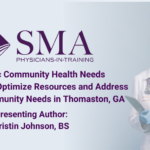Abstract | May 7, 2021
A Pediatric Community Health Needs Assessment to Optimize Resources and Address Identified Community Needs in Thomaston, GA
Learning Objectives
- To determine the major health indicators that impact health outcomes within rural pediatric populations;
- To identify social determinants of health;
- To identify the social determinants of health that impact health outcomes within rural pediatric populations;
- To discuss methods of a community needs assessment.
Background/Significance:
Health outcomes in the United States can differ based on geographic location. The health service infrastructure, health service utilization, health status and access to care can be impacted by location which can create disparities distributed between cities and rural areas. Georgia is one of the many states that displays this disproportion in health disparities between the thriving metropolitan areas of the state and the rural communities of Georgia. Thomaston is a city located in Upson County, GA which is designated by the Federal Office of Rural Health Policy as rural at 46.91% of the county population. Additionally, 22.3 % of the total Upson County population are children under the age of 18 with 31% of those children living in poverty.
Social determinants of health such as economic stability, neighborhood and physical environment, education and healthcare systems have an impact on health outcomes. Upstream prevention by addressing social determinants of health early on in a child or adolescent’s life is of vital importance since it shapes an individual’s long-term health trajectory and can shift the culture and health outcomes of an entire community.
Methods:
A total of 6 community key informants participated in the study and were asked a set of 15 questions to gain insight on the critical needs and concerns for children and adolescent health and quality of health, community resources and assets, recent changes in the community, the strengths and weaknesses of the community along with difference in quality of health among different groups within the community. The Robert Wood Johnson Foundation and the University of Wisconsin Population Health Institute’s 2019 County Health Rankings & Roadmaps program’s online database was used to analyze community health indicators. Additional indicators were included from the Rural Health Information Hub for Georgia and the Annie E. Casey Foundation’s Kids Count data center project.
Results:
The needs of the pediatric population were identified and discussed with the most prevalent concerns being poverty, lack of mental health services, substance abuse, lack of health education, high teen birth rates, increase in children in foster care along with a lack of resident knowledge on how to access and utilize community resources. The social determinants of health that contributed to these health disparities were economic instability, neighborhood location, education, community and social context as well as the health care system in rural Georgia. The identified resources and community assets were the internal and external non-profit community service organizations, Upson County Medical Center, the Georgia Department of Public Health, Zoe Pediatrics, Upson County Community Service Board, Southern Crescent Technical College, the Upson County Chamber of Commerce, the Thomaston Police Department’s Champs program, the Heritage Pregnancy and Family Health Center, Thomaston-Upson County School District.
Conclusions and Implications:
Thomaston, a rural community in Georgia has sustained disparities in health outcomes due to social determinants of health including access to medical care, geographic location and economic stability. The Pediatric Community Health Needs Assessment (PCHNA) provided insight on the critical needs and concerns for children and adolescent’s along with community organizations which can address these issues. Investments in early health care that supports brain and child development have documented high near-term returns in the form of increased school readiness, reduced special education, and reduced costs for grade retention and English language learning. They also generate long-term returns through higher graduation rates, greater employment and increased lifetime job earnings. All of these add up to a more productive workforce, a stronger economy and higher business profits. Thomaston has a wealth of support from longstanding members in the community as well as both in-house and external organizations willing to provide assistance. The issue lies in the residents becoming informed on how to access and utilize these given resources. The programs and initiatives identified in the PCHNA can enhance the quality of health and health care for children and families in the community through enhanced partnerships to improve visibility of these programs as well as access and use resulting in lasting sustainable relationships within the community.

